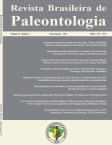TRAÇOS FÓSSEIS DOS DEPÓSITOS MARINHOS RASOS DA FORMAÇÃO PITINGA, SILURIANO SUPERIOR DA BACIA DO AMAZONAS, RIO TAPAJÓS, PA, BRASIL
DOI:
https://doi.org/10.4072/18Abstract
TRACE FOSSILS FROM SHALLOW MARINE DEPOSITS OF THE PITINGA FORMATION, UPPER SILURIAN OF THE AMAZONAS BASIN, TAPAJÓS RIVER, STATE OF PARÁ, BRAZIL. The Silurian-Devonian interval of the Amazonas Basin exhibits low trace fossils diversity. Transgressive post-glacial deposits (upper Silurian) in the Tapajós River edge shows a trace fossils assemblage composed by Arthrophycus, Beaconites, Bifungites, Diplichnites, Lockeia, Monocraterion, Planolites and Phycodes, also indeterminate tubes and indeterminate arthropod scratches. This assemblage illustrates the Cruziana Ichnofacies preserved in laminated siltstone, wavy bedding sandstone with tabular and sigmoidal cross-stratification. The integration of ichnologic and sedimentologic datasets suggests a wave-dominated shallow marine palaeoenvironment. The predominance of epifaunal trace fossils indicates relatively calm water and deposition just below of the fair-weather wave base. The tracemakers were mostly worms and arthropods, but also rare bivalves. The gradual retreat of glaciers in the Silurian–Devonian transition led to the eustatic rise and the emergence of news ecospace in transgressive post-glacial sea. Thereby, the low icnofaunistic diversity could be related to cold seas that dominated the Gondwana coast enabling infaunal occupation by organisms adapted to the environment stress during the Silurian. Oscillations in the sedimentation rates and erosion of the shallow-tiers traces fossils may also be responsible by the low diversity recorded in the studied deposits.
Key words: trace fossils, Pitinga Formation, Tapajós River, upper Silurian, Amazonas Basin.
Downloads
Downloads
Published
How to Cite
Issue
Section
License
This is an Open Access article distributed under the terms of the Creative Commons Attribution-NonCommercial-NoDerivatives license (http://creativecommons.org/licenses/by-nc-nd/4.0), which permits non-commercial re-use, distribution, and reproduction in any medium, provided that no alterations are made and the original article is properly cited. The written permission of Revista Brasileira de Paleontologia must be obtained before any commercial use and/or adaptation of the article.







